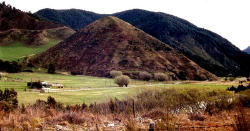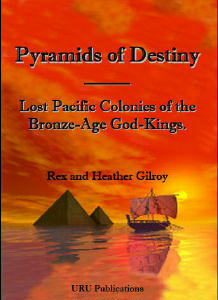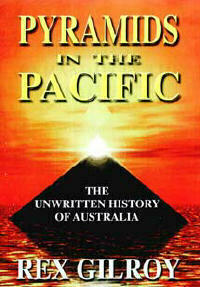
| Pyramids of Destiny – Lost Pacific Colonies of the Bronze-Age God-Kings |

|
The story is by now well known, how one day in January 1965, while exploring dense Blue Mountains scrub overlooking a valley, I made my first discovery of this civilisation, in the form of a 15 metre tall mound composed of sandstone boulders and rubble, being the remains of a ceremonial structure.
About half way up the mound stood a large weathered rock, bearing on its northern side the facial features of a reptile, and on the other, the profile image of a human face. Later measurement of the mound’s base revealed it to be 315m in circumference. A search of other nearby rocks to the west soon revealed another ‘serpent’ altar’, carved atop a 3m tall sandstone block. Photo copyright © Rex Gilroy 2009. |
Pyramids of Destiny – Lost Pacific Colonies of the Bronze-Age God-Kings
by Rex & Heather Gilroy
Copyright
© Rex Gilroy 2009
| “And on this point he [Poseidonius] does well to cite the statement of Plato that it is possible the story about the island of Atlantis is not fiction. Concerning Atlantis …an island no smaller in size than a continent.”
Strabo [64BC – 201AD] |
“Today honest inquirers after knowledge object to being gulled by mere pretenders, even if these boast the titles of doctor and professor in a university”. Augustus Le Plongeon MD. [1826-1908] |
Part One.
The Rise of Civilisation Out of Australia – The Children of the Uru.
Chapter Two.
Not From Atlantis – The Rise of Uru.
The Leeville, New South Wales, fossil shoe in authors possession.Taditions hoary with age extending from Asia to Europe, and throughout the myriad of Pacific Islands to the Americas, speak of a golden race of people who once lived upon a paradisial island continent; a god-like fair-skinned race who arose in the dawn mists of a mystical golden age, the age of gods.
Upon this island continent they created a unique culture and civilisation. While many primitive humans beyond this paradise still inhabited caves, this golden race had explored, surveyed and mapped the world.
With an advanced mathematical knowledge and astronomical science, which aided their maritime achievements, they also developed an advanced agriculture. They knew the medicinal properties of plants which aided their advanced medical science; and they also created a highly organised religious philosophy, with a supreme being at the head of pantheon of lesser deities.
In the course of time they would establish colonies across the earth, their culture influencing the eventual rise of all other civilisations, both in the Old and New Worlds. Then, as mysteriously as it had arisen, this great civilisation and its creators would vanish, leaving in their wake the weathered monuments of their great culture to mystify Man down through the ages.
This great ‘mother’ civilisation was the first World Power of antiquity, a super-civilisation to whom we owe a debt of gratitude for the priceless legacy they have left us, for it is to them alone that we should look for the very beginnings of our modern civilisation.
The above scenario may sound like a brief description of the rise and fall of fabled Atlantis, but it is not, for I am describing here a civilisation so ancient as to confound conservative scholars, who traditionally place the beginnings of civilisation back a mere 6,000 years.
The foregoing paragraphs, lifted from my book “Uru – the Lost Civilisation of Australia” are pertinent to the subject of this book now in the reader’s hands for it was the race-memory of the fabled “Lost Paradise of Mankind” located ‘somewhere’ in the southernmost region of the world, which led the later maritime civilisations of the Old and later the New Worlds to sail in search of the “Land of Origin” and the limitless riches believed to lie there.
I discovered this ‘Australantis’ after considerable, often tiring fieldwork in frequently difficult terrain. Inspired by ancient Aboriginal traditions which, as my book “Pyramids in the Pacific – The Unwritten History of Australia” states, speak of a race of “culture-heroes” who inhabited the land before them in the long-ago ‘Dreamtime’.
These culture-heroes are variously described as a pale or white-skinned race that shaped many natural geological features throughout the land, and erected many, often truly monolithic rock formations, and worshipped the Sun, Moon and Stars. They influenced Aboriginal religion, giving them Sun, Earth-Mother and Sky-Father worship and other aspects of their ceremonial life. They taught the Aboriginal warriors the use of the woomera in spear-throwing and the manufacture of the boomerang.
Yet, when I first published my theory and earliest discoveries in the press in the mid-1980s I was immediately attacked by establishment academics, with the familiar cried of ‘impossible’, and that I was wasting my time and money searching for something that was nothing more than an Aboriginal myth!
The story is by now well known, how one day in January 1965, while exploring dense Blue Mountains scrub overlooking a valley, I made my first discovery of this civilisation, in the form of a 15 metre tall mound composed of sandstone boulders and rubble, being the remains of a ceremonial structure.
On its western side stone slab steps led to the summit, where I found upon a flat base, facing east, a large altar stone whose flat top had been carved in the form of a serpent.
The altar, standing on a north-south axis, measured 1.7m long by 70cm wide and 1.2m high. The serpent, caved in relief in a curved aspect, bore a groove at its northern [head] end representing its mouth. Beside the altar was a large boulder bearing a long, deep, wide groove.
This groove represents the single stroke sometimes used in ancient Uruan script to denote the letter ‘Na’. However, at this early stage I had no knowledge of the identity of the ancient builders.
About half way up the mound stood a large weathered rock, bearing on its northern side the facial features of a reptile, and on the other, the profile image of a human face. Later measurement of the mound’s base revealed it to be 315m in circumference. A search of other nearby rocks to the west soon revealed another ‘serpent’ altar’, carved atop a 3m tall sandstone block.
The serpent, cut in relief, measures 3.9m in length by 30cm wide at the head, the body width measuring from 15 to 34cm as it broadens in width towards the rounded end forming the altar itself. There is also a deep groove cut into the left side of the mid-body. This groove also probably represents the Uruan letter ‘Na’, ‘N’ being short for ‘Nim’, the name of the Uruan Sun-God, as I was to discover.
These altars formed a long-abandoned ceremonial ground. That they all face the east identifies them with Sun-worship.
Another much larger altar, carved in relief in the form of an eagle, was found by me in 1973, a few kilometres to the south, reached by climbing a 6m tall sandstone rock. The bird measures 72cm in length from head to tail, by 128cm width from its closed left wing to outstretched right wing, which like the beak, points south. Once again this altar faces east.
Having met my wife Heather the previous year, we were now a ‘team’ determined to locate, map, measure and photograph every megalithic site we could find.
Learning of mystery stone arrangements found in widely scattered areas of central western New South Wales, in 1974 we began extensive field investigations thereabouts, which continue to the present day.
A Bathurst area farming family informed us of a lengthy stone alignment on their granite-covered property. Excited at the immense importance of these stones, we commenced an investigation there that would confirm my theory.
The stones, averaging 54.6kg in weight, extended in a line from south to north, measuring from as little as 60cm to one or two metres apart for up to 2km. We found that measurements for the varying distances between each stone were repeated at intervals throughout the alignment, suggesting a mathematical purpose.
We later examined a second alignment, 4km to the east that another farmer reported to us. Subsequent measuring showed it to be the same length, on a north-south axis, the measurements between each stone producing much the same results as before.
On another investigation, and nearby the southern end of the first alignment, we discovered a large granite menhir [standing stone] 4.6m tall by 3m in circumference, erected upon a base of partly buried blocks forming a platform 4.8m square.
By now we realised that we had discovered the remains of an unknown ‘lost’ civilisation of megalith-building people that had arisen here in the dim past to develop a highly advanced astronomical science.
We pondered that, whatever the identity of these people; they were certainly not the Aborigines, who were never stonemasons. It was obvious that the Aborigines had once shared Australia with a race possessing a higher culture than their own.
Libation bowls are a feature of stone arrangements worldwide. One good example we found among the Bathurst megaliths and carved into a granite boulder is unique; measuring 30cm wide by 60cm long and 90cm deep.
Yet it is a mystery as to how it was carved, for the granite in this district blunts any modern engineer’s drill! How the ancient stonemasons accomplished this task remains a mystery.
Main Book Index | Mysterious Australia Homepage | URU Homepage | Australian Yowie Research Centre


